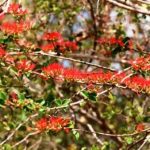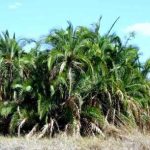TREE LIFE
DECEMBER 1993
The Chairman and Committee members wish all our members and their families a really happy Christmas and hope that 1994 will be a good year for all of us.
MASHONALAND CALENDAR
Sunday 5th December : We are holding a joint meeting with members of the History Society for our Christmas social/December outing this year. John and Stella Danckwerts are once again allowing us to enjoy their wonderful woodland on their farm Chedgelow, which is near the airport and borders on Henry Hallam Dam. The trees and shrubs are expected to be magnificient at this time of year. Our tree ramble will be from 9.30 to about ll.30. At about 11.45 Mr Tim Tanser will give a brief dissertation on the original owner of the farm, William Harvey Brown who was also a pioneer. Bring a picnic lunch or, if you prefer to braai, fires will be available.
Tuesday 7th December: Botanic Garden Walk. Park at the Herberium where we will meet Tom Muller at 4.45 for 5 pm.
Saturday 1st January 1994 : Meet at the Mukuvisi Woodlands car park at 3.00 for Mark’s Botanic Interest Walk. The area he proposes to explore has in the past revealed some very interesting species.
Tuesday 4th January : Botanic Garden Walk.
MATABELELAND CALENDAR
Sunday 5th December : The Second Acacia School. Meet at Girls’ College for an 0830 hour departure. Please be prompt. You might find it useful to bring along a clip board and a pen or pencil. As we will be providing hand-outs please phone Ian or Margaret (evenings at 41946) to confirm your attendance. This will ensure that we print enough material. Also bring tea things and chairs for afterwards.
Monday 13th December : Urban Trails, Hillside Dams at 4.45 for 5 pm.
Saturday 1st January : our New Years Day Social at the Raubs.
Sunday 2nd January : Special request a return to Roy Stevens’ property, Shumba Shabe. Makulu in the eastern Matopos. Meet at Girls‘ College for a prompt 8.30 departure. An all day outing.
A joint Bulawayo and Harare trip to Gwaai is being planned for the first week-end in February, ’94 with perhaps an extra day tagged on. Details are not yet finalised, but accommodation could be at either Ivory Lodge or Gwaai River Hotel. It will assist planning if numbers are known so please inform Ian Mccausland on Bulawayo 41946 or Maureen Silva-Jones on Harare 25837 in the evenings if you wish to be included.
BOTANIC GARDEN WALK : 2 NOVEMBER 1993
On a warm November evening, about 16 members of the Society gathered outside the Herbarium for another walk with Tom.
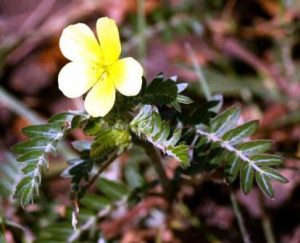
Tribulus terrestris. Photo: Bart Wursten. Source: Flora of Zimbabwe
Quite close by, Tom introduced us to a small blue-flowered bush with compound, paripinnate leaves with 2-5 pairs of leaflets. This was “lignum-vitae”, which Tom mentioned is the national flower of Jamaica. It has exceptionally heavy wood, which actually sinks in water. The species is Guaiacum officinale which belongs to the ZYGOPHYLLACEAE, which is represented in Zimbabwe by the genus Tribulus. Tribulus terrestris is a prostrate yellow-flowered species which can cover large areas with yellow flowers, especially at medium and lower altitutdes.
Also nearby was a selection of mature pot-plants. Amongst these was a large Ficus benjamina, with its glossy dark green leaves and weeping branches. This is an Asian tree and because, like all figs, a specific species of gall-wasp is required to fertilize it, it never produces mature figs in the Gardens.
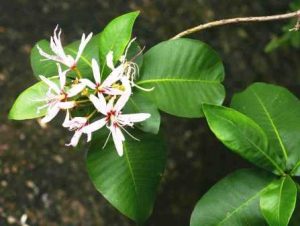
Calodendrum capense. Photo: Bart Wursten. Source: Flora of Zimbabwe
Quite close as well was Calodendrum capense, looking magnificent with its pink clusters of flowers. This is a species of forest edges, especially in the Cashel/Chimanimani areas. However, in the Mutema Communal Lands, there is a forest in which it is the main tree in its own right. The translucent dots in the leaves indicating RUTACEAE were examined.
After a short walk through the forest section, we came upon another member of the RUTACEAE, Citropsis daweana. This has the same glandular dots in the leaves, but the leaves this time were pinnate with a winged rhachis. The plant itself was scented with a vaguely Citrus-like smell. By this time we were in the lowveld section and to assist with the illusion, the smell of the Potato Creeper became quite noticeable in the dusk. Close by was Acacia welwitsochii looking very similar in appearance to Loetzei, with its hooked thorns and white flower spikes, Tom explained that welwitchii is indeed closely related to goetzei and that it is a rare, but possibly overlooked species in Zimbabwe. It occurs only at low altitudes in the SE, fringing small streams in Gone-re-Zhou.
On to Oncoba spinosa, a species in the FLAGOURTIACEAE, which was in flower showing a mass of stamens. It occurs mainly on alluvium and deeper soils in the Valley, but strangely is also to be found at quite high altitudes on the watershed east of Harare, for example at 1560m altitude at Halfway House near Headlands.
The strange flower of the Pod Mahogany Afzelia quanzensis was examined. This has one petal, a number of staminodes (infertile stamens) and true fertile stamens. The flowers are a darkish-red and not easy to see as they tend lurk among the leaves. The pods are of course exceptionally thick and heavy.
The interesting flowers of Cladostemonn kirkii CAPPARACEAE were examined and the androgynophore (the stalk bearing the ovary and stamens) was clearly visible. The flowers themselves are white turning yellow as they go over. A certain amount of excitement was generated when Anne spotted a fruit high among the branches – this was an astonishingly large object, shaped a bit like a hefty light bulb. This was the first time that fruit had been seen on this particular species in the Gardens.
We examined again the fascinating tangle of Strophanthus kombe and Xylia torreana. The Xylia had spherical clusters of orange flowers (which proclaimed its membership of the sub-family MIMMOSOIDEAE) and distinctive thick flattened 1-seeded pods. This is again a species of low altitudes.
Once again, our thanks go to Tom for sharing his knowledge with us.
-Mark Hyde
THE WORLD‘S HARD AND HEAVY TIMBERS
During the Botanic Garden walk with Tom Muller on 2 November we were shown a young specimen of Guaiacum officinale (Family ZYGOPHYLLACEAE), a tree from the West Indies and tropical America. The wood of this tree is known as lignum vitae, for long famous as the hardest and heaviest timber in the world. Its density is 1250 kg per cubic metre, which is extremely heavy, and as density and hardness usually go hand in hand, the density of any wood is generally a good indicator of its hardness.
All timbers that have a density of more than 1000 kg per cubic metre will sink in water, and there is a surprisingly long List of them. The 20th century has seen the opening up of many tropical forests and the discovery of timbers that are even harder and heavier than lignum vitae these, and a few close contenders, are listed below and I’m sure that most of the genera will be familiar:
Piratinera guinanensis (MORACEAE) snakewood; Central America & trop South America; density 1300.
Caesalpinea echinata (CAESALPINICIDEAE) brazilwood; Brazil; 1280
Caesalpinea granadillo (CAESALPINIOIDEAE) partridgewood; Venezuela; 1230.
Erythrophleum chlorostachys (CAESALPINPOIDEAE); Cooktown ironwood; northern Australia;
Brya ebenus (PAPILIOHNOIDEAE); Cocuswood; West Indies; 1200
Dalbergia cearensis (PAPILIONOIDEAE) ; kingwood; Brazil; 1200
Dalbergia retusa (PAPILIONIDEAE); cocobolo; Central America; 1200
Zimbabwe, too, has some very hard and heavy woods, for example:
Manilkara mochisia (SAPOTACEAE); lowveld milkberry; 1250
Acacia erioloba (MIMOSOIDEAE); camel thorn; 1230
Combretum imberbe (COMBRETACEAE); leadwood; 1230
Tamarindus indica (caesalpinioideae); tamarind; 1220
Dalbergia melanoxylon (PAPO;OPMPODEAE); African blackwood; 1200
Colophospermum mopane (CAESALPINIOIDEAE) mopane; 1200
More than 30 other Zimbabwean trees produce wood with densities in excess of 1000 kg per cubic metre.
In his Zambezi Journals (1858-1863) David Livingstone wrote that he had used upwards of one hundred and fifty tons of lignum vitae alone for firing the boilers of his river boats. The wood was that of Combretum imberbe, but it was not without reason that he called it lignum vitae.
There is an erroneous belief that Burma teak, Tectena grandis, has a very hard wood but it has a density of only 360 kg per cubic metre; our own Zambezi teak, Baikiaea plurijuga has a density of 815, and mukwa Pterocarpus angolensis, 640 as well below the real “heavies”. At the bottom end of the scale are mugongo, Ricinodendron rautanenii, 180and balsa Ochroma pyramidale 150 (exactly half the density of baobab).
-L.J.Mullin
GLEN DOUGLAS 21ST NOVEMBER 1993
From the shade of the Brachystegia woodland and its resident cicada population some fifty members guests ambled out into the hot sunshine towards a dry vlei and some interesting looking woodland beyond.
Combretum adenogenium (fragrans) were very common and the leaves had an almost synthetic green colour. The highly conspicuous veining and leaves in threes made identification relatively easy. A few stunted Flueggea virosa (snow berry) were seen, their small obovate leaves also a brilliant green. Once across the vlei the _ woodland opened and Pterocarpus rotundifolius, several superb Pterocarpus angolensis (with their single dead branch) and Loncocarpus capassa heavily laden with maturing seeds. As always a clump of _Zyzphus mucronata managed to snag somebody’s sleeve on their effective forward and backward hooked thorns.
Browsing giraffe had found the young leaves on a Strychnos spinosa to be most palatable and had left a browse line around the tree. Lannea discolor had also suffered from browsers but this time probably young elephant as some branches had been broken off and strewn about. A large rough-barked tree puzzled us for a while and after some “mystree” comments, a piece plucked from high in the branches confirmed some members suggestions of an Ekebergia seneguelensis, the pale red leaf rachis not being visible from the ground. Another set of leaves, this time large, opposite and dark green with a pink underside, were identified as being those of a Diospyros kirkii. As an added help several small leaves were “tucked in” between the larger leaves creating a rather untidy looking leaf structure.
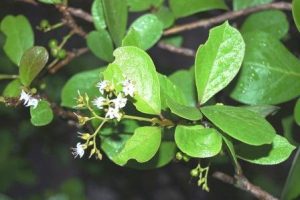
Ehretia amoena. Photo: Stefaan Dondeyne. Source: Flora of Zimbabwe
One of the interesting “finds” of the day were many flowering Ehretia amoena, the mass of lax mauve blooms hanging down against the dark green leaves behind were quite a sight. However, the effect of rubbing ones fingers over scabrid hairs on the hairs on the leaf indicates that this species is well protected against browsing animals. A small and very spiny “thing” growing in the path was eventually identified as a Commiphora schimperi Interestingly enough the small highly serrated leaflets produced a mint like smell when crushed. After this bit of excitement the word, “crocodile” was uttered and we trooped over to the dam wall to have a look at the “flat dog” lurking in the warm shallows of the rapidly drying dam.
After a relaxing break back in the confines of the car park a group of tame young elephants arrived and proceeded to enjoy the muddy water at the dam fringe. Shortly after a tractor and trailer appeared and a convoy of vehicles formed and we headed deeper into the game park.
Not quite an armchair safari but being on the trailer was very handy and we were able to see Buffalo, Zebra, ostriches and Impala close by with Tsesscebe further away. In between recording several Acacia species including A.goetzii subsp. microphylla and the papery bark Acacia sieberiana we came across a herd of young male Sable antelope, a few of which had well developed horns. A large number of reddish pods were noticed hanging from an Albizia versicolor which was well away from the road and to debus from a jolting trailer would have been unwise. Near the farmhouse a surprise was waiting in the fem of two male lion cubs named Caesar and Major in their large wire mesh pen. Although very tame and playful their strength was noticeable and Alexander Lind turned pale when Major rose on his hind legs to exchange a greeting (friendly )through the wire mesh.
As always these super days in the bush end too quickly and we returned to gather our bits and pieces and head for home.
Very many thanks to Roy and Pam Guthrie for entry to their game Park, the bonus of a game drive and the absolute luxury of a bush loo and water cart and to Angus who made us so welcome and ensured our safety with the game guards.
-Andy Macnaughtan
NYARPINDA CATCHMENT November 1993
Hello again, Hi! is the greeting everywhere, in England, Canada and Australia where we have been. Three editions of “Tree Life” awaited our return to Tinto. Reading them filled that jetlag twilight time when routine can be postponed for a few hours more, this was a pleasant way of coming back to reality.
“Tree Life” feedback
No. 153 “Seeing Red”, Scarab-type beetles have defoliated several large Brachystegia boehmii trees, their limp tasteless non green leaves have been demolished, shrivelled remains of them litter the ground, will there be another flush of leaves? Having had their fill let us hope that the culprits have …. beetled off.
No. 165 The account of Hunting Safari on the Zambezi written by A.C, Sinclair was a delightful reminder that we were back home in Zimbabwe, after a journey of more than fifty thousand kilometres. Thank you A.C.S.
The Scene : What a wonderful November, from time to time showers have freshened and clarified the air and the vari-coloured Spring/Summer foliage is nearly perfect in the dry deciduous woodland. Birds sing or call all day, the Red-Chested Cuckoo continues during the night, this morning six African Hoopoes took off from the garden towards the bush where they called hour after hour.
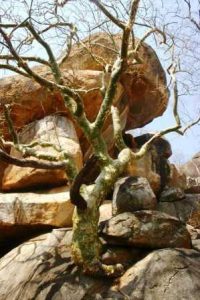
Commiphora marlothii. Photo: Bart Wursten. Source: Flora of Zimbabwe
Overlooking the catchment, the kopjes form part of the watershed, this is where myriads of insects hum among the boughs of Commiphora marlothii, Acacia sieberana, Kirkia acuminate and the jasmine tree Holarrhena febrifuga, all in flower now, the latter is earlier than in the proceeding drought years. Ochna puberula in the speckled shade is like a sunbeam touching the ground, its closely massed yellow flowers almost hide its finely serrated leaves which are light brown.
Silently the butterflies and moths add their colour to this scene amongst the rocks. This week our neighbour Paul Zwanikken noticed numerous slow-flying white moths Pseudaphelia apollinaris which resemble butterflies because they are diurnal (and nocturnal”). The book states that this species is associated with Turraea nilotioa, Paul has not seen the horned-caterpillars of these Apollo moths. Pearly Charaxes, green-edged Swallow-tails, many versions of Red Tips and others were there and evaded capture. Paul has collected a less common ? species of Christmas beetle which is brown and unlike Platypleura rutherfordii as illustrated in Bundu Book 2 page 43.
Here are some Holiday Notes :
England : In the Cotswolds we visited Westonbirt Arboretum to see the autumn colours of the maple trees in the Acer Glade. Maple syrup comes from indigenous trees which grow in the east of Canada.
Canada : Two bottles of genuine 100 per cent maple syrup travelled nearly as far as we did on the way to Zimbabwe. In Canada we spent two days in the most beautiful place in the world at the Mount Assiniboine Park in British Columbia. This place is marked in the map Supplement to the National Geographic April 1992, look for the border with south western Alberta. Our base was Nanton a little town at the edge of the prairies not far from the foothils of the Rocky Mountains. The mountain guide was my friend‘s husband, Ken, who is in his eighties, he was born at Golden (which is marked on the map west of Banff) so he knew the Canadian Rockies, with their jagged peaks, shimmering lakes, glistening glaciers and grey moraines. He led a small party of us on three ‘easy’. hikes alorg trails through forests of spruce, fir and lodgepole pine, the latter famed the lodge where we stayed. Higher up, above 2100 metres above Sea level we were surrounded by alpine larch, alpine fir and Engleman spruce, low-growing willows and bog birch grew near the mountain streams and in vlei like places towards the lakes. The larch is deciduous and was golden coloured prior to leaf fall, it contrasted with the evergreen conifers. All this was illuminated with the bright sunshine of a (Red) Indian Summer, it was late in September and luckily for us the Chinook (a warm wind) persisted and brought this good weather. On the second morning we set off in fine snow and it was very cold after we -had walked uphill for nearly 4 km. and stopped on a rather bare summit at the tree line. Larch trees are very slow growing. Many years ago Ken led a team of dendrologists, who with their increment borer proved that the oldest-looking larches were more than 850 years old, their centres had become hollow so they were older than the number of growth rings. Their annual growing period last three months, June July and August. Ken showed us a tree which had been sampled, it was unharmed. He drew our attention to the absence of middle aged larches on the mountain sides. We could only guess at the reason for this, perhaps the climatologists know what happened, was there a long period of intense cold which prevented germination, who knows. A small souvenir of dry larch wood 13 mm in diameter demonstrates its slow growth, it has more than 25 annual rings. This sample is the smallest treasure in the collection of wood-in-the-round at Tinto.
Unfortunately there was no time to verify the scientific names of the trees we saw at Assiniboine, no doubt the Herbarium library would provide this information.
Last but not least is that wild strawberry plants occurred in the ground cover of the alpine terrain, the cold weather prevented them from bearing fruit in all but the mildest summers.
See you soon at Chedgelow on December 5th,’ all being well. We will bring some photos of the mountains in the sunshine, and tell you about the precautions to be observed concerning “grizzlies”.
-Benedicta Graves
THORA HARTLEY‘ S HERBAL
Ken and Thora Hartley have a wonderful garden on the old Gwanda Road. It’s a Plants man’s paradise full of all manner of interesting subjects but their chief specialties are herbs and pelargoniums.
Thora has a profound knowledge of herbs, both exotic and local and this extends to usage both culinary and therapeutic. We have asked her to share their rich fund of information with us and she has very kindly acceded to do this. So over the next few issues Thora Hartleys Herbal will be a regular feature.
THE SOLANUM FAMILY
Potato – Solanum tuberosum
It took a long time before the potato was accepted due to fear and suspicion because it belonged to the poisonous solanaceous family. There are over 1500 known varieties and it is hard to imagine a daily diet in which the potato does not feature. Eaten raw it was the remedy for scurvy on long sea voyages. Grated raw potato taken ten minutes before a meal is an excellent remedy for stomach ulcers and also controls diarrhoea. The addition of carrot juice and honey makes it more palatable. Externally, grated raw potato relives the pain from burns, sunburn and chilblains. Slices of raw potato freshly cut and applied to the temples soothes headaches and migraine. Placed on the closed eyelids the slices reduce puffiness and redress and also untire the eyes. I personally have found this an excellent and quick relief for itchiness and irritation, far more soothing than prescribed drops to which I have often proved allergic.
A cut potato held in the hands overnight will draw out the pain from rheumatic fingers. In fact placed anywhere on the body and strapped in place, will through the process of osmosis, draw out pain and reduce swelling and bruising. Try it, it’s excellent. ‘
N.B. Boiled potatoes should be eaten fresh and never kept longer than twelve hours.
Bitter Apple — Solanum sodomeum (Panduriforme)
This indigenous member of the potato family grows along the roadsides from the Cape to Zimbabwe. It is a spiny plant with pale mauve flowers and yellow and green striped fruits like marples. Although the fruits are poisonous, used externally, they have remarkable medicinal uses. The sliced fruit merely rubbed on to ringworm 2 – 3 times a day is quick cure in both animals and humans.
It also clears up an infection of sandworm overnight. Other skin infections have also been cured.
Africans use a tee of the root for treating coughs and tight chests. A piece of the root tied round the waist, wrist or neck is considered a magical protection against poisoning and harm.
Garden Nightshade – Solanum nigrum
This plant grows in many places throughout the world and readily seeds itself all over the garden. It has probably become naturalized here. The small plant has small white flowers followed by clusters of green and finally black berries. The green berries are poisonous and like Solanum sodoneum can be used externally for skin ailments. The black ripe berries are not toxic and make a delicious jam rich in vitamin C.
The ripe fruit crushed and mixed with honey make, a cough mixture for colds and post nasal drip. A tea made from the ripe fruit is used to treat heart conditions, liver ailments, eye diseases and is also a tonic.
Some African tribes use the ripe fruit in their rain ritual — the fruit representing the black clouds.
The leaves are cooked as spinach and considered to be blood cleansing and energizing. Made into a tea, the drink is used for fevers, malaria, convulsions, headaches, dysentery and as a sedative. The leaf tea is also used to wash wounds, ulcers and infected rashes.
In fact this plant has been used for centuries for a wide variety of ailments.
LOOKS COULD KILL
Appearances can be deceptive. Householders have been seduced for years with the idea of fitting out their kitchens with easy-to-wipe surfaces, and throwing out those old wooden cutting boards in favour of shiny new plastic ones. So much more hygienic, it is thought.
Dean Oliver and Nese Ak, two researchers at the University of Wisconsin, Madison beg to differ . They set out to find ways of decontaminating wooden kitchen surfaces and ended up finding that such surfaces are pretty good at decontaminating themselves.
Working with wood from nine different species of tree, four sorts of plastic, and even an old rubber chopping board, the results were always the same, when they spread their gut wrenching bacteria – Salmonella, Listeria and Escherichia coli – over various samples and left them there for three minutes, the level of bacteria on the plastic (or the rubber) remained unchanged while the level on the wood plummeted, often by as much as 99.9%. Left overnight at room temperature, the bacteria on the plastic actually multiplied, while the wooden surfaces cleaned themselves so thoroughly that Dr. Oliver and Ms Ak could not recover anything from them at all.
At first sight these results seem astonishing. But, unlike polymer chemists, plants have spent hundreds of millions of years fighting bacteria. They should, by now, be pretty good at it. And trees might be expected to be the best of the lot. After all, they live longer – not only longer than most plants, but longer than most animals as well. And even when a tree is dead, its wood can hang around for decades, resisting the attacks of micro-organisms. Slaughtering a few Salmonella should be child’s play.
Dr. Oliver and Ms Ak do not yet know exactly what is happening, but their guess is that the porous structure of the wood is soaking up the fluid with the bacteria in it. Once inside, the bacteria stick to the wood’s fibres and are “strangled” by one of the many noxious anti-microbial chemicals with which living trees protect themselves – exactly which, they have not yet worked out. But they are searching. In the meantime, perhaps surgeons general should look out their old chopping blocks.
Extract from “The Economist ” Feb. 15th 1995. Acknowledged with thanks to author and publisher.
I have just read Chris Ferris‘ book ‘The Darkness is Light Enough‘, which must surely rank amongst the most enchanting, fascinating and beautiful books ever written on nature.
It contains the following passage –
It seems to me that the landscapers of the eighteenth century who planned the estates and parks we enjoy were incredible people. To plant trees, not for your life time or your children’s, but for those two centuries ahead, and to see in your mind’s eye what a place would look like in that time‘, requires humility and vision. To always be aware that you are merely the instrument by which these things are done – never the creator – requires humility. To plant a tree is one thing, to create a life-force is something different, and to see it grow is a small miracle. One can merely plant with a sense of vision and hope that vision will live on and flourish.
-Rolf Chenaux-Repond
ANDY MACNAUGHTAN CHAIRMAN


